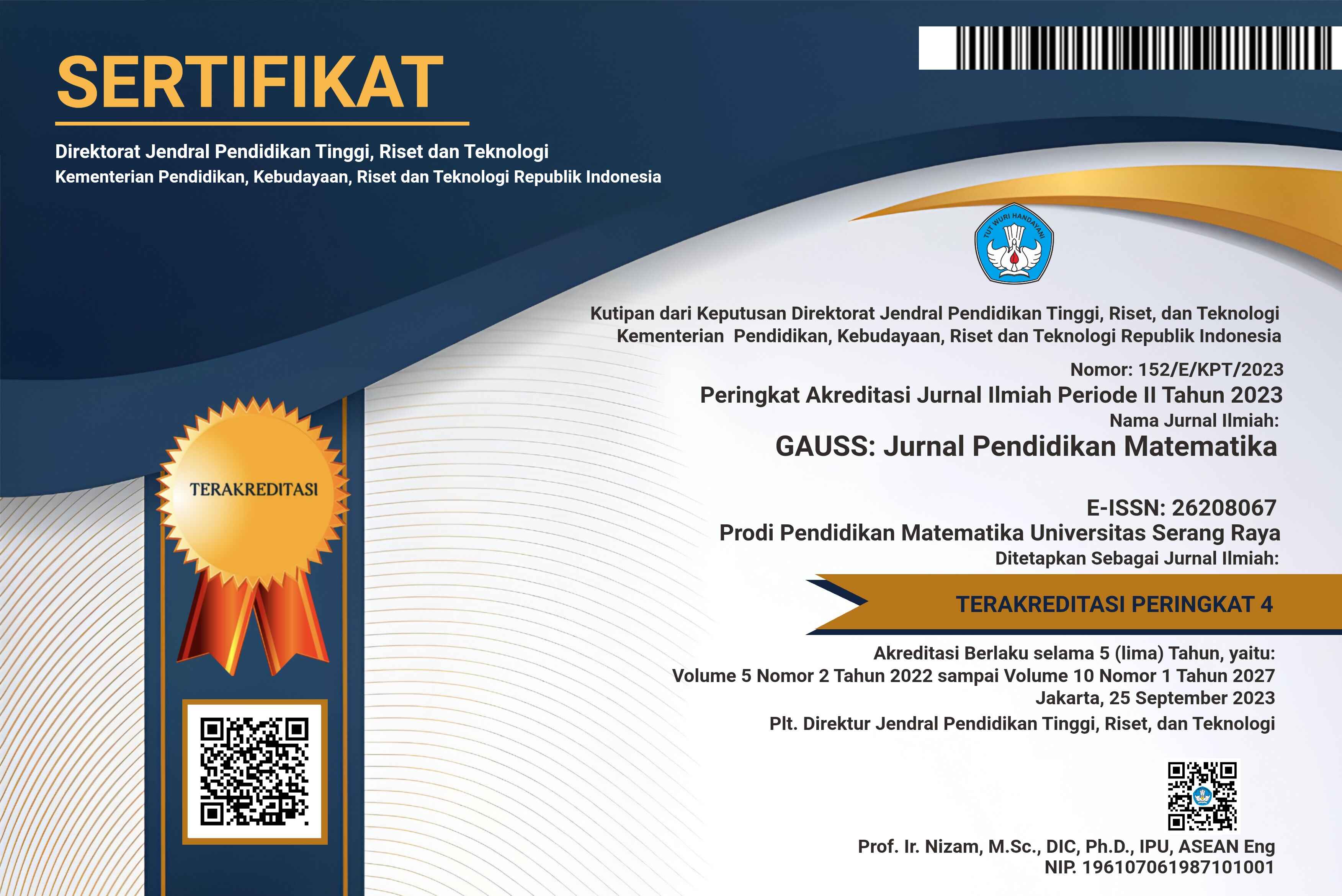Kemampuan Computational Thinking Siswa pada Materi Pola Bilangan ditinjau dari Self-Efficacy
DOI:
https://doi.org/10.30656/gauss.v8i1.10655Abstract
Abstrak
Computational thinking adalah kemapuan berpikir sistematis yang mengintegrasikan proses logis, analitis, dan kreatif untuk menyelesaikan masalah kompleks. Penelitian ini bertujuan untuk mendeksripsikan kemampuan computational thinking siswa ditinjau dari tingkat self-efficacy. Penelitian ini merupakan penelitian kualitatif deskiptif. Subjek dari penelitian ini adalah 33 siswa kelas VIII yang diberikan tes angket self-efficacy. Selanjutnya, akan dipilih sebanyak 9 siswa untuk mengerjakan tes computational thinking dengan pembagian 3 siswa self-efficacy rendah, 3 siswa self-efficacy sedang, dan 3 siswa self-efficacy tinggi. instrumen penelitian yang digunakan berupa angket self-efficacy, tes uraian, dan wawancara. Analisis data yang digunakan mengacu pada model analisis Miles dan Huberman yang meliputi reduksi data, penyajian data, dan penarikan kesimpulan. Hasil penelitian menunjukkan terdapat 8 siswa dengan self-efficacy tinggi, 15 siswa dengan self-efficacy sedang, dan 10 siswa dengan self-efficacy rendah. Siswa dengan tingkat self-efficacy tinggi mampu memenuhi 4 aspek kemampuan computational thinking, siswa dengan tingkat self-efficacy sedang mampu memenuhi 3 aspek kemampuan computational thinking, dan siswa dengan tingkat self-efficacy rendah mampu memenuhi 2 aspek kemampuan computational thinking.
Kata kunci: computational thinking, self-efficacy, pola bilangan
Abstract
Computational thinking is the ability to think systematically by integrating logical, analytical, and creative processes to solve complex problems. This study aims to describe students' computational thinking abilities in terms of their level of self-efficacy. The research is a descriptive qualitative study. The subjects of this study were 33 eighth-grade students who were given a self-efficacy questionnaire. Subsequently, 9 students were selected to take a computational thinking test, consisting of 3 students with low self-efficacy, 3 students with moderate self-efficacy, and 3 students with high self-efficacy. The research instruments used included a self-efficacy questionnaire, open-ended tests, and interviews. Data analysis referred to the Miles and Huberman model, which includes data reduction, data display, and conclusion drawing. The results showed that 8 students had high self-efficacy, 15 students had moderate self-efficacy, and 10 students had low self-efficacy. Students with high self-efficacy were able to fulfill all four aspects of computational thinking, students with moderate self-efficacy fulfilled three aspects, and students with low self-efficacy fulfilled two aspects of computational thinking.
Keywords: computational thinking, self-efficacy, number pattern
Downloads
Published
Issue
Section
License
Copyright (c) 2025 Muhammad Ali Bintang Istofany, Afifurrahman, Habibi Ratu Perwira Negara

This work is licensed under a Creative Commons Attribution-NonCommercial-ShareAlike 4.0 International License.
Authors who publish articles in GAUSS : JURNAL PENDIDIKAN MATEMATIKA agree to the following terms:
- Authors retain copyright and grant the journal the right of first publication with the work simultaneously licensed under a Creative Commons Attribution-ShareAlike 4.0 International License that allows others to share the work with an acknowledgment of the work's authorship and initial publication in this journal.
- Authors are able to enter into separate, additional contractual arrangements for the non-exclusive distribution of the journal's published version of the work (e.g., post it to an institutional repository or publish it in a book), with an acknowledgment of its initial publication in this journal.
- Authors are permitted and encouraged to post their work online (e.g., in institutional repositories or on their website) before and during the submission process, as it can lead to productive exchanges, as well as earlier and greater citation of published work (See The Effect of Open Access).




